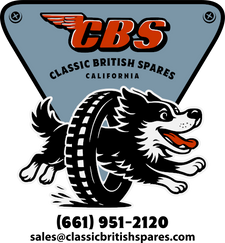Explained: 1971-1972 Triumph & BSA Conical Hub Brake Lever Differences
Know The Difference: 1971-1972 Triumph & BSA Rear Brake Lever & Spring
In 1971 the BSA motorcycle company introduced a new generation of frames called the "oil bearing frame" or simply known in short as the "OIF". Triumph also tagged along with the new style frame. With the frame design being new, there where also new hubs fitted to the models called the "conical hub". The conical hub was fitted on most Triumph & BSA singles, twins, and even triples from 1971-1975. In this blog we will be focusing on the rear conical hub brake lever arm and return spring from 1971-1972 only as the 2 years they where different and we will explain why, and how to identify what you have. This information will also help you find the correct parts should you have to replace your rear brake components.
![]()

Shown above is the 1971 brake lever arm set-up. The red arrows shows the brake lever arm pointing "down". This was only used for one year.
![]()

Shown above is the late rear brake lever arm set-up. The red arrows show the brake lever arm pointing "up". As fitted to rear conical hubs from 1972-1975.
Let's start with 1971. In 1971 Triumph & BSA motorcycles with the rear conical hub had a rear brake lever arm that pointed "down". The brake rod it's self would be next to your passengers ankle which in essence could be very dangerous. In 1972 along with many other frame changes for that year, the rear brake lever arm was "flipped", opposite from 1971. Instead of the arm pointing "down", it would now be pointing "upward" and away from your passengers ankle. Well, not completely away but better then the 1971 design. As pictured above, the first photo is the 1971 variety which shows the red arrow pointing to the brake lever and also pointing in the down direction. The second photo shows the 1972-1975 variety which shows the lever pointing "up". Although they look the same they are different.
![]()
The factory actually had to come out with 2 different parts each year to make this work which can be seen in the rear wheel parts catalog section above. The 2 major components are the brake lever, and the rear brake lever return spring. All the brake lever cams from 1971-1975 remained the same. The 1971 rear brake lever and spring are not the same as the 1972-1975 types and should not be interchanged, only if the rear brake lever and return spring are changed alltogether. Although the 1971 and 1972 rear brakes are somewhat different, the Triumph and BSA parts books for each year do show the correct part numbers but the diagrams did not change. Do not rely on parts books images as many times they used previous years design but just changed the part number. We see that in this case. Are there any benefits from each year? Is the 1971 verson better then the 1972-1975 versions? I personally dont see any difference but the factory did. I just wantedto shed some light on this becausemany folks are not aware of the differenceS! Now that we have shown you the differences, you can see the specifications below for more detailed information.
![]()
Specifications
Below you find the complete specifications for the Triumph & BSA rear brake lever and spring for 1971-1972 models. 1972 rear brake set-ups happened to stay the same until 1975. Click on the part numbers below should you need to order any of the parts from our site.
1971 Only Triumph & BSA Part Number'sRear Brake Cam Lever 37-3877Rear Brake Lever Return Spring 37-3880
1972-1975 Only Triumph & BSA Part Number's
Rear Brake Cam Lever 37-4034Rear Brake Lever Return Spring 37-4049
|


Classic British Spares
@Roy Smith Thank you!
Roy Smith.
Enjoyed the info, thank you.
Classic British Spares
@ED Watling thanks for reading the post today ED!
ED Watling
Excellent presentation! Thank you for your efforts!